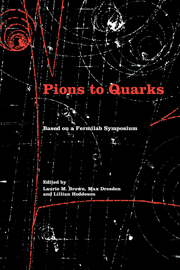Book contents
- Frontmatter
- Contents
- List of contributors
- Foreword by Leon M. Lederman
- Editors' acknowledgments
- Photographs of the symposium
- List of abbreviations
- List of notation
- I Introduction
- II Particle discoveries in cosmic rays
- III High-energy nuclear physics
- IV The new laboratory
- V The strange particles
- VI Weak interactions
- VII Weak interactions and parity nonconservation
- VIII The particle physics community
- IX Theories of hadrons
- 39 The early S-matrix theory and its propagation (1942–1952)
- 40 From field theory to phenomenology: the history of dispersion relations
- 41 Particles as S-matrix poles: hadron democracy
- 42 The general theory of quantized fields in the 1950s
- 43 The classification and structure of hadrons
- 44 Gauge principle, vector-meson dominance, and spontaneous symmetry breaking
- X Personal overviews
- Name index
- Subject index
42 - The general theory of quantized fields in the 1950s
Published online by Cambridge University Press: 07 May 2010
- Frontmatter
- Contents
- List of contributors
- Foreword by Leon M. Lederman
- Editors' acknowledgments
- Photographs of the symposium
- List of abbreviations
- List of notation
- I Introduction
- II Particle discoveries in cosmic rays
- III High-energy nuclear physics
- IV The new laboratory
- V The strange particles
- VI Weak interactions
- VII Weak interactions and parity nonconservation
- VIII The particle physics community
- IX Theories of hadrons
- 39 The early S-matrix theory and its propagation (1942–1952)
- 40 From field theory to phenomenology: the history of dispersion relations
- 41 Particles as S-matrix poles: hadron democracy
- 42 The general theory of quantized fields in the 1950s
- 43 The classification and structure of hadrons
- 44 Gauge principle, vector-meson dominance, and spontaneous symmetry breaking
- X Personal overviews
- Name index
- Subject index
Summary
Introduction
At the beginning of the 1950s, the outlook for elementary particle theory was strongly influenced by the success of renormalization theory for quantum electrodynamics. As a result of the efforts of Sin-itiro Tomonaga, Julian Schwinger, Richard P. Feynman, Freeman Dyson, and others, the quantum field theory of Dirac spin-½ particles interacting with radiation had been solved, in the sense that well-defined formal power series in the finestructure constant could be fairly unambiguously attributed to various quantities of interest and gave spectacular agreement with experiment, for the gyromagnetic ratio of the electron and the Lamb shift in hydrogen, in particular. Attention turned to the problem of giving a nonperturbative treatment. This was urgent, because the burgeoning demands of strong-interaction physics made it unlikely that perturbative methods would be of practical significance in that area. The responses were varied; as examples, consider dispersion theory, axiomatic field theory, the Schwinger action principle, and the Feynman path integral. What many of these efforts had in common was then somewhat novel: They attempted to encapsulate the currently existing understanding of the relativistic quantum theory of fields in a general theory of quantized fields. From a logical point of view, they can be viewed as attempts to systematize and bring to logical completion the process that had occurred in renormalization theory, in which the initially ambiguous equations of quantum electrodynamics were given a precise meaning and greater predictive power.
- Type
- Chapter
- Information
- Pions to QuarksParticle Physics in the 1950s, pp. 608 - 629Publisher: Cambridge University PressPrint publication year: 1989
- 4
- Cited by



